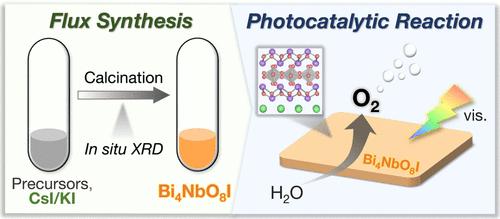siill - aurivillius oxyioide可见光水裂解光催化通量合成
IF 7
2区 材料科学
Q2 CHEMISTRY, PHYSICAL
引用次数: 0
摘要
具有sill本文章由计算机程序翻译,如有差异,请以英文原文为准。

Flux Synthesis of Sillén–Aurivillius Oxyiodide for Visible Light Water Splitting Photocatalysis
Iodine-based compounds with a Sillén–Aurivillius layered perovskite structure are promising photocatalysts for visible-light-induced water splitting. However, their synthetic method has been limited to solid-state reaction (SSR), which restricts the material tunability and thus photocatalytic performance. Here, we report a liquid-phase synthesis of Sillén–Aurivillius oxyiodide Bi4NbO8I via the flux method. An appropriate choice of reaction conditions, including flux, precursor, and calcination atmosphere/temperature, is required for the single-phase formation due to the complex crystal growth mechanism, as revealed by in situ synchrotron X-ray diffraction measurements. The provided plate-like particles are of excellent crystallinity with size tunability. The superior charge carrier transport property of the flux sample, as shown by time-resolved microwave conductivity measurements, allows its higher photocatalytic water oxidation activity than the sample prepared via conventional SSR. An appropriate surface modification further exploits the superior bulk property of the flux sample, achieving the highest performance reported for oxyiodide photocatalysts with an apparent quantum efficiency for sacrificial O2 evolution of 8.8% at 405 nm. This study provides a solution-based synthetic approach to the complex layered oxyiodides, broadening their potential for solar-to-energy conversion systems.
求助全文
通过发布文献求助,成功后即可免费获取论文全文。
去求助
来源期刊

Chemistry of Materials
工程技术-材料科学:综合
CiteScore
14.10
自引率
5.80%
发文量
929
审稿时长
1.5 months
期刊介绍:
The journal Chemistry of Materials focuses on publishing original research at the intersection of materials science and chemistry. The studies published in the journal involve chemistry as a prominent component and explore topics such as the design, synthesis, characterization, processing, understanding, and application of functional or potentially functional materials. The journal covers various areas of interest, including inorganic and organic solid-state chemistry, nanomaterials, biomaterials, thin films and polymers, and composite/hybrid materials. The journal particularly seeks papers that highlight the creation or development of innovative materials with novel optical, electrical, magnetic, catalytic, or mechanical properties. It is essential that manuscripts on these topics have a primary focus on the chemistry of materials and represent a significant advancement compared to prior research. Before external reviews are sought, submitted manuscripts undergo a review process by a minimum of two editors to ensure their appropriateness for the journal and the presence of sufficient evidence of a significant advance that will be of broad interest to the materials chemistry community.
 求助内容:
求助内容: 应助结果提醒方式:
应助结果提醒方式:


